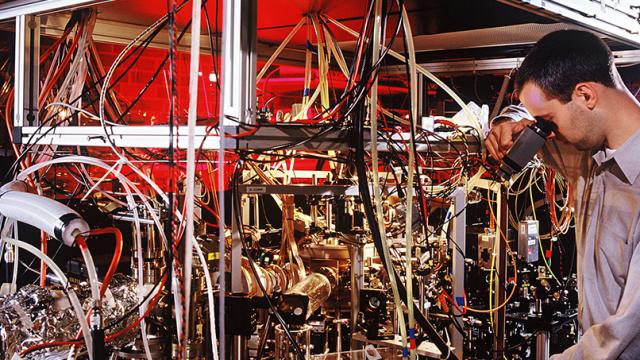Here’s your dose of mind-bending physics for the day. In 1970, a young Soviet physicist named Vitaly Efimov proposed a trio of ultracold particles could arrange themselves in an “infinite nesting-doll configuration”. Scientists have now published compelling evidence that this state of matter, once dismissed by physicists, totally does exist.
Picture: The machine used to trap and cool ultracold cesium atoms. C. Lackner/Institute for Quantum Optics and Quantum Information
Like most of us, physicists themselves were perplexed when they first heard of what is called now called the Efimov state. But Efimov’s maths has held up in the four and a half decades since, and technological advances have even allowed physicists to achieve the Efimov state in a lab.
The balance of forces acting on three particles allows for the Efimov state. In her piece for Quanta Magazine, journalist Natalie Wolochover valiantly wades into the quantum mechanics behind it:
The nesting-doll feature — called discrete scale invariance — arose from a symmetry in the equation describing the forces between three particles. If the particles satisfied the equation when spaced a certain distance apart, then the same particles spaced 22.7 times farther apart were also a solution. This number, called a “scaling factor,” emerged from the mathematics as inexplicably as pi, the ratio between a circle’s circumference and diameter.
“It’s like layers of an onion,” [physics professor] Randy Hulet said. “You see molecules at one layer. Peel the layer away, and you see that there’s a molecule there 22.7 times smaller. Every time you peel away a layer, you find another molecule.”
Totally bizarre, huh? Well the Efimov state only happens at ultracold temperatures — like 10-billionth of a degree above Absolute Zero — when all types of weird things happen to matter. In 2006, physicists at the University of Innsbruck in Austria managed to supercool three cesium atoms that did in fact configure as Efimov predicted. Though that didn’t prove the weirdest part of the Efimov state, of course, which is the 22.7 scaling effect.
But now we have it: the same group of Austrian physicists has observed a second Efimov trimer, exactly 22.7 times bigger. Two other groups have also observed Efimov trimers at different sizes by substituting a lithium atom for one of three cesiums. Evidence from three separate research groups is pretty convincing.
The Efimov state may still be obscure sounding, but it reveals a law for how molecules in the universe interact, a law that allows for, in Wolochover’s words, “a geometric progression of evermore-enormous trios of particles, spanning in a theoretically infinite sequence from the quantum scale to (if the particles were cold enough) the size of the universe and beyond.” It’s pretty cold — but also pretty cool. [Physical Review Letters via Quanta Magazine, Scientific American]
